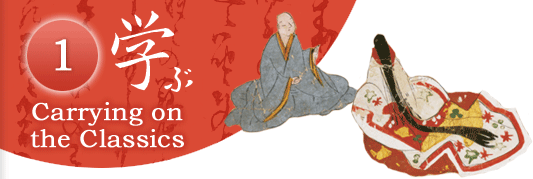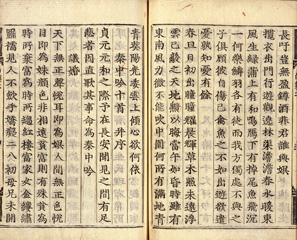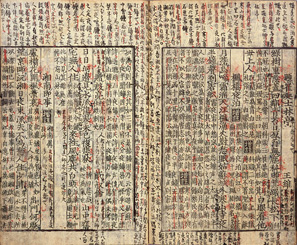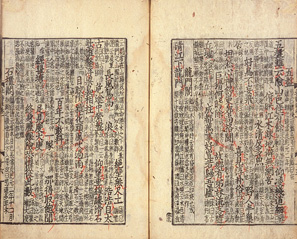A collection of poems by Bai Juyi (772 to 846), a famous poet in Tang, China. Old movable-type edition. This version shows the original organization of the poems; so a facsimile version was published in the prewar China based on this one.
Home > 1. Carrying on the Classics > History and Chinese Books 2
26. Hakushi monju (Bai shi wen ji)
- 71 volumes, by Bai Juyi (of the Tang Dynasty, China), printed by Nawa Doen in the 4th year of the Genna Era (1618), 15 books, 28.1
 19.6cm <WA7-76>
19.6cm <WA7-76>
27. Hakushi monju sho
- Volume I, by Bai Juyi (of the Tang Dynasty, China), copied by Anin in the 2nd year of the Kencho Era (1250), 1 book, 26.4
 16.5cm <WA15-8>
16.5cm <WA15-8>
Poems were selected from Volumes I, II and V of Hakushi monjyu. Old manuscripts that still remain in Japan, including this, show how books were transcribed by hand in the Tang Dynasty. Today, they are very valuable and useful materials for emending text.
28. Zochu token zekku santaishiho (Zeng zhu tang xian jue ju san ti shi fa)
- 3 volumes, by Zhou Bi (of the Song Dynasty, China), noted by Yuan Zhi (of the Yuan Dynasty, China), additionally noted by Pei Yu (of the Yuan Dynasty, China), printed at the end of the Muromachi Period (16th century), 3 books (bound in one volume), 27.7
 18.2cm <WA6-20>
18.2cm <WA6-20>
Anthology of Chinese poems in the Tang Dynasty. Compiled in 1250. In Japan, this Chinese-style poetry grew widely popular in the Muromachi Period and thereafter. Numerous notes are inserted in the exhibit, Volume I.
29. Shusenkachu bunrui tokobushi (Ji qian jia zhu fen lei du gong bu shi)
- 25 volumes, by Du Fu (of the Tan Dynasty, China), noted by Xu Juren (of the Song Dynasty, China), supplementally noted by Huang He (of the Song Dynasty, China), printed by Kanki (of Kyoto) in the 2nd year of the Eiwa Era (1376), 10 books, 25.5
 17.2cm <WA6-29>
17.2cm <WA6-29>
A collection of poems by Du Fu (712 to 770), a famous Chinese poet in the Tang Dynasty. The exhibit is Gozan-ban edition This is a reprinted edition of a printed book in the Yuan Dynasty. Woodblocks were engraved by artisans coming from China.








